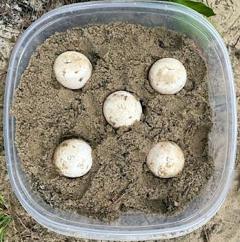
When it comes to protecting one of the oldest living species on the planet, it takes both big and small actions. In Georgia, landowner Herbert Hodge has spent the past 12 years restoring pine savannas across his 400-acre farm and has witnessed gopher tortoises make a remarkable comeback.
“There are definitely more gopher tortoises. After restoration, they picked up their suitcases and moved on in. I don’t know where they came from...they weren’t there when we were planting,” said Hodge.
What it means to be a keystone species
The gopher tortoise is one of the oldest homebuilders east of the Mississippi River and in technical terms, a keystone species in the longleaf ecosystems of the Southeast. A species is considered keystone when a large part of a particular ecosystem is dependent upon its survival.
Gopher tortoises have a tremendous impact on the environment with the burrows they create, providing protection from elements, fire and predators for approximately 350 other animals, which all require healthy longleaf ecosystems to thrive. Thus, scientists recognize the gopher tortoise as one of the most important species in North America, with habitats scattered across most of the Southeast.

In recent decades, numerous factors such as disease, injury, and the loss of habitat due to an increase in land development projects, have led to a decline in gopher tortoises, jeopardizing the stability of longleaf ecosystems and the species that depend on them.
About the Conservation Plan
Typically, conservation plans aren’t established until after a species is added to the threatened or endangered species list. While the population in the western range is listed as federally threatened, the eastern population has evaded listing altogether, due largely to proactive conservation efforts.
The gopher tortoise represents a key example of strategic conservation success. Behind the scenes, conservationists with the USDA Forest Service, Natural Resources Conservation Service, U.S. Fish and Wildlife Service, state agencies, nonprofits and landowners have led an effort to preserve the species. The Forest Service and partner agencies are using programs such as the agency’s Forest Stewardship program and Conservation Reserve Program to help provide landowners with access to knowledge and other resources to assist in the conservation of the gopher tortoise.
“The work we are doing is proactive and groundbreaking to help the gopher tortoise thrive,” said Lynn Lewis, landowner assistance program manager with the Forest Service, Southern Region. “Hopefully in the future other high priority species, like Bobwhite quail and Eastern indigo snakes, will also see a boost in populations since they share the same habitat.”
This means gopher tortoise conservation must go beyond rehabilitating individual tortoises. Foresters and biologists must resurrect entire pine savannas to provide adequate food and space for gopher tortoise survival.
“As more species continue to be imperiled by habitat loss, it’s critical we learn from the success of saving the gopher tortoise. The earlier we start engaging landowners, instituting state-level policies and conserving land, the better off the species will be,'' said Lewis.
On the ground
Florida, home to the largest gopher tortoise population, has instituted numerous habitat restoration programs to aid the gopher tortoise. Notably, the National Environmental Policy Act, allows the Forest Service to carry out habitat improvement environmental assessments. These assessments include removing overgrown midstory hardwood shrubs from federal land to provide a suitable environment for the gopher tortoise.
Fire is another crucial habitat preservation tool. In Florida alone, the Forest Service treats almost 200,000 acres with fire every year. Without prescribed fire intervals of every two to three years, the habitats transform from open savannas into shaded forests where gopher tortoises and other species can’t thrive.

Landowner collaboration is also critical to gopher tortoise survival as nearly 86% of the South’s 212 million acres of forested land is privately owned. The Forest Service and partners are working together to restore and establish good habitat for the tortoise by promoting good stewardship practices across all lands, through landowner assistance programs and outreach efforts.
Many, like Herbert Hodge, have devoted their livelihoods and free time to protecting gopher tortoises. In Cape Coral, Florida, a couple bought acreage adjoining their home to guarantee their neighbor, a gopher tortoise, would be neither harmed nor relocated by land development.
Other landowners have observed similar phenomena. Reese Thompson, who operates a tree farm in Georgia, became passionate about restoring pine savanna ecosystems after learning of their importance and unparalleled biodiversity. In the past 40 years, Thompson has been busy planting longleaf pines on his farm and conducting controlled burns to create habitats for endangered species. As the pine savannas returned, so did the gopher tortoises and they are multiplying quickly.
“Private lands are pivotal. By managing for gopher tortoises, we are not only managing for that species, but we are also creating healthy forests to keep those lands as working (economically and ecologically viable) lands,” said Lewis. “Our goal is keeping our forests working. You can do both and benefit everyone - the public, the landowner, and even wildfire suppression efforts.”

Editor’s Note: for more information about the gopher tortoise please visit the links below.
Forest Service feature on gopher tortoise babies
National Forest Foundation feature






